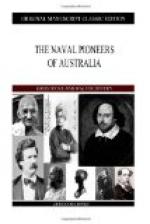There died in February, 1898, in Melbourne, Australia, Lieutenant Pascoe, son of Nelson’s flag-lieutenant at Trafalgar, so that the first proposition is established. Now Nelson’s Pascoe could easily have been patted on the head by Cook, and the father of any of Cook’s men could easily have sailed with Dampier. Looked at in this way, it does not seem difficult to span the gulfs between each of these naval epochs, and if one compares Dampier’s Roebuck and her crew with Cook’s Endeavour and her crew and with the ships and seamen of Nelson’s time, it still seems easy enough; but between us and them steam and iron have come, and we are as far apart from those others as the Martians are from us.
At the time when Cook started on his voyage England had for several years been engaged in, and was almost constantly at, naval war. From the French and Spanish prizes we got many valuable hints in the designing of ships, and our builders improved upon them with the best workmanship and materials in the world, so that the warships of Cook’s time differed little from, and in many cases were, the hulks which, until very recent years, lay in our naval seaports. It ought not to be necessary to remind readers that Nelson’s Victory, still afloat in Portsmouth harbour, was launched in 1765.
[Illustration: CAPTAIN JAMES COOK, R.N. From picture in the National Portrait Gallery, painted by John Webber, K.A. To face p. 48.]
The sailors were for the most part pressed men, but there was a notable difference between them and the seamen of Dampier’s time. They were, and remained for long after, wild, improvident, overgrown children such as the nautical novelists who wrote a few years later [Sidenote: 1769] have pictured them; but the lawless rascals who manned king’s ships or were pirates by turns, as fortune provided, were rapidly dying out, and veterans of the Spanish main were mostly to be found spending the evening of their days spinning yarns of treasure islands to the yokels of the village alehouse.
One of the causes which led to this improvement in the class of seamen was the disgraceful behaviour of the crew of the Wager, a ship of Anson’s squadron, when she was lost off the Horn in 1740. A good deal of the trouble was owing to the then state of the law, by which the pay of and control over a ship’s company ceased upon her wreck. The law was so amended as to enlist seamen until regularly discharged from the service by the captain of the ship under the orders of the Admiralty.
The food of sailors and the accommodation provided for them were little, if any, better than these things had been fifty years before—for the matter of that than they remained for fifty years later, and to the shame of those responsible, than the food still is in many merchant ships, for even now occasionally we hear of cases of scurvy on shipboard—a disease which Cook, over 120 years ago, avoided, though voyaging in such a manner as nowadays is unknown.




